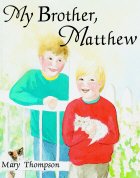Archived Resources
/https://siu.edu/search-results.php
Last Updated: Jul 07, 2025, 01:30 PM
September 2005 - Back to School
Easy Access Clothing Click on “online store” to find clothing that is stylish and accommodates for various needs. Easy Access Clothing offers 100% satisfaction. A catalog is available online or by calling 1-800-775-5536.
Specially For You
This company designs, sews and sells adaptive clothing for those with special needs. A catalog is available online or by calling 605-765-9396, or you my write to Specially For You, Inc. 15621 309th Ave., Gettysburg, SD 57442.
Finally It Fits Great styles and great prices. We strongly recommend taking a look at this site. Designs are adaptive to fit your child’s individual needs. Visit online or call 408-476-0223.
Accessible Threads This site will provide custom made clothing to meet your child’s needs or make alterations to already purchased clothing. You may also contact them by calling 770-355-3281.
Adaptable Designs, Inc.
This site has a wide variety of bags and pouches to fit wheelchairs and walkers. These bags can help your child become one step closer to independence through easy access to books, pens, pencils, and other school supplies.
October 2005 - Halloween Costumes and Treats
This October you can impress guests with these great fast treats and great creative costumes. The following web sites have great ideas for October festive costumes and treats for the party. It might take a little time to create some of the costumes but our kids are definitely worth it. Everyone will be impressed. There are also fast recipe ideas that you and your children can make together.
Costumes
http://sewing.about.com/library/weekly/aahallow04a.htm
Links to over 150 costumes ideas to kick start your imagination. Many of them require little to no sewing. You can piece together various ideas to create one costume.
http://www.halloweenishere.com/costume_ideas.html
Scroll down to the section on costume ideas for wheelchairs, canes, and crutches for directions on costumes that accommodate for special equipment. Some even includes respirators. Sorry no pictures, but great ideas.
http://members.aol.com/pumpkinave/costumes/handicapped.htm
This web site has more fun ideas for costumes that meet the needs of special equipment. There are some great ideas.
http://www.bellaonline.com/articles/art5640.asp
Here are some "outside the box" ideas that you can pull off inexpensively. Depending on your mood, these will either accentuate or disguise a disability.
Great Treats
http://www.weightlossweekly.com/frank-in-stein.html
This link will provide a recipe for a low calorie punch for any party.
http://familycrafts.about.com/od/halloweentreats/
This web site will provide 70 quick and easy treat ideas for a fun Halloween party. Some ideas can be used for all party occasions. The kids may be able to help with some of the recipes. Some of the treats are healthy and great to eat and some are just fun and great to eat.
http://www.homeandfamilynetwork.com/food/kids.html
This site has a lot of quick meals and snacks that children and adults will like and can fix together. Some of these snacks can be used at parties and some you may want to keep for your home only.
November 2005 - Fast Eats and Crafty Thanksgiving Treats
Mashed Sweet Potatoes with Apples
This web page has a wonderful recipe your child(ren) can help you make. Sweet potatoes are cooked then mashed with cooked chopped apples, brown sugar, butter and other seasonings. After you have cooked the potatoes and apples let them cool to a safe temperature then allow your child to smash them with a whisk.
Chicken Fingers Five Ingredient Meal
At this page you will find a good nutritious meal that the children will love to eat. Yes, it's true! Just five ingredients make a full meal that is especially kid-friendly. Let the children help by placing the ingredients in the pot before putting it on the heat.
Microwave Cookie Candy Turkeys
This web page has a fun Thanksgiving sweet treat the children will love to help with. Let the kids place the chocolate and Carmel pieces on the plate and watch as they magically turn into a turkey. All will love the treat and it will add a nice touch to the Thanksgiving theme.
Wax Paper Thanksgiving Placemats
These placemats are a fun craft the whole family can do together. Go to this web page to find step-by-step directions on how to put together these fun placemats. Children can collect outdoor items and use them to create a nice Fall display for Thanksgiving guests. You may choose to use them on your tables or hang them in the window. To add more color and a little “wow” add some crayon shavings between the two sheets of paper to blend colors. Be careful not to get the paper too hot and you should place an old newspaper underneath for surface protection.
Collecting and Learning about Autumn Leaves
Go to this web site to get a fun project you can do with the children. Have the children look at the different leaf shapes then go on a walk and see how many leaves they can find. Give them a bag to put the leaves in and when you get back in the house dump them out and match them to the shapes of the leaves on the paper. Ask the children the questions and write their answer (whatever their answer is) on the blanks. Put it together as a scrap book to look at and show friends and family. Next year do the same project and see how they change their answers from year to year.
More Thanksgiving Crafts and activities
Here you will find several simple craft ideas that will add to your Autumn decorations around the house. From scarecrows made of fabric and straw, and scarecrow door hangings to Fall leaf wreaths. Click on the links at the top of the page to find a variety of Autumn/ Thanksgiving decoration ideas the kids can help create.
December 2005 - Holiday Gift Ideas for Children With Special Needs
Here are some links to great holiday gift shopping for that child with special needs on your list.
Try this site to find a variety of toys that fits the child’s special needs that is on your list.Toys "R" Us has put together a nice site that directs you to toys designed to help your child individual needs. In the “Browse Differently Abled” box in the top left corner you can click on the different skills that your child may need to work on.
A couple of my favorites were:
 |
The Discovery Ball by Leap Frog |
 |
The Aquadoodle by Spin Master for only $19.95. |
Come Play With Me has some neat ideas.
Click on the “enter” link, then search for the toy that will help the child you have in mind. I thought searching by “category” then “therapy tools” was a nice way to find toys that are beneficial to each unique need.
The Lekotek website is a great web site that brings learning and fun together for children with special needs. It also has a lending library or toy lending program, and a resource helpline.
"Let's Play" at the University of Buffalo may not have a list of toys but it can help you to decide what toys are best for your child, how to use the toys to meet your child’s needs and desires. It also has valuable information on how to adapt the toys you have or toys they want to your child’s motor needs. This web site is full of information to help you make the most of the toys your child wants.
The Therapy Toy Shop has wonderful toys that meet special needs. It has links to many items and is a must see web site. Music, toys, assistive technology, parent guide and information books, and much more can be found at this site. There is something for all ages.
Achievement Products for Children is another nice web site. It has a variety of products from motor skill development toys, daily living skill devices, furniture and more. Some great ideas for holiday gift giving. My favorite was the music cloud chair. It is pricey but really cool. The perfect vibroacoustic beanbag chair is used to help positioning, calming hyperactivity, relaxing and entertaining.
January/February 2006 - Fun Things To Do
This is a fun way to create many things. Your child can play and create all types of things with this playdough and you do not have to worry about them eating it and getting sick because it is made of food.
Edible Playdough
Edible playdough 1 can chocolate frosting mix (betty Crocker) 1 cup peanut butter 1 1/2 cups dry powdered milk Knead until right consistency. Should not be sticky. More peanut butter may be used but then use more dry powdered milk.
May be pinched off as clay, or rolled into balls, or shaped flat as cookies, etc.
This is a fun recipe you can allow the kids to do by themselves without the worry of getting burnt.
No Cook No Bake Snowball Cookies
Ingredients
Marshmellow fluff, creamy peanut butter, cereal (Rice Krispies or flakes), and powdered sugar.
Mix in a mixing bowl, 1 & ½ cups of marshmallow fluff/cream, 1 cup of creamy peanut butter, and a cereal (I like using Rice Krispies. If you use flake cereal you might want to crush it in a bag.) Have kids roll into small balls and then roll into powdered sugar.
A fun art project your child can do that uses items you might have around the house is food color art. The children can do most of the project by themselves.
Food color Art
What you need,
- Typing paper
- Food coloring
- A tub slightly larger than the typing paper (a cookie sheet works well but is easier to spill)
- Water
You might want rubber gloves to prevent food color stain on hands.
Fill the tub or cookie sheet with water almost full.
Have paper ready to dip in the water.
Have the child put drops of food color in the water.
Drop a paper on the water then pull it back out.
The color should blend and create a tie-die effect. You can explore what colors combine to create new colors. (Red + Blue = Purple, Yellow + Red = Orange, Blue + Yellow = Green)
Scavenger Hunt
A fun indoor or outdoor activity is scavenger hunts. Create a list of items on paper or on tape. You might take pictures of items to be collected and place them on a paper list. Allow you child a certain amount of time to locate the items. Before they begin to look have rewards for different amounts of items found. 1 item a hug, 2 items a special drink. List a reward for each amount of items found. This could be a great opportunity to allow them to use the phone and practice social or language skills.
Safe, fun and educational water play:
Mathematic concepts can be learned using a variety of inexpensive materials. Assorted containers and funnels can help children develop concepts such as empty/full, before/after, shallow/deep, and heavy/light.
Individual water tubs at a table are great for enhancing fine motor skills.
For younger children, eye-hand coordination can be practiced by retrieving objects with tongs, aquarium nets, scoops, and fingers. Small muscles get a workout as plastic tubes are fitted to funnels and sponges are wrung dry. Very young children may also enjoy spending many happy moments repetitively filling and emptying containers.
Children can learn about measurement by using measuring cups or discovering the best way to squirt long and short distances using squeeze bottles or plant misters filled with water.
A child's vocabulary is enriched as she uses words such as funnel, surface, float, and strain. Adults can promote language acquisition by adding foam or rubber alphabet letters or numbers to a container filled with water to be fished out with nets. Name the letters or numbers they catch, spell out their names, or see who can catch the highest or lowest number.
Make cleaning up part of the learning experience using rags and short-handled mops to do "grown-up" work.
Create a dramatic play area for children to wash doll clothes in a tub of sudsy water and hang them up with clothespins to dry.
Even on cool days, children can "paint" with water. Set up a paint shop by providing a large paintbrush and partially fill a large can or small pail with water. They can pretend to "paint" a variety of surfaces.
Provide a water tub for experiments and projects. Boats can be made from found objects or heavy aluminum foil. Older preschoolers can try out predictions by determining which of a variety of seeds and assorted items will float.
Fun Things to Do, Part 2 - February 2006
There is a web site called Fun Attic that has several different ideas for fun indoor activities for home.
Gayle's Preschool Rainbow has a variety of fun activities that can be done indoors. If it gets nice outside, you can also click on Outdoor Fun on the menu at the left side of the page.
Games Kids Play is a web site with many indoor ideas. You can read about games that focus on memory skill building and motor skill building.
March 2006 - Money Saving and Life Care Information
Fun and Therapeutic Items
All of the following items were found at the Abilitations and Integrations web sites. Some can be seen through the catalogs only. For a catalog you can order on the website or by calling 1-800-622-0638.
The following were some of our favorite items:
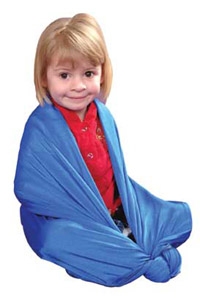
Abilitations® CuddleLoop™
Provides A Swaddle Effect For Kids
Designed by a therapist, CuddleLoop provides a tight, snuggly, swaddle effect for all kids, but is highly effective for kids with sensory processing challenges. CuddleLoops can be used in seated or lying positions and can be knotted and wrapped to meet a particular need or comfort. Each loop is made of a stretchable LYCRA® material. You can place a knot or fastener (not included) at any point to tighten it as shown. Loops fit children from 6 months to approximately 8 years of age (18 lbs.-45 lbs.). $24.95 each
Tender Vibes™ Soothing Mattress
Some children respond to the calming input of vibration. This toddler- size mattress will lay on top of a twin bed mattress. It has an oversized on/off button for easy operation. It automatically turns off after 15 minutes. It uses 2 “D” cell batteries. The soothing mattress measures 28”W x 52”L. $171.99 each
Therapy Net
This net can be hung to provide linear movement total body extension and help make sitting muscles stronger. It’s large enough for children of all sizes and adults. It is designed to stretch and flex without binding or pinching. It can hold up to 200 pounds. Accessories are available. The accessory that I liked was the study board. $73.29 each (Accessories sold separately)
Chair Hugger
Soft pliable and adjustable LYCRA sheet adapts to nearly any chair and any child. It provides a gentle pressure that helps to calm a child while they sit in a chair. It is not intended as s restraint but as a support for short interval setting. One size fits all ages. $31.59 each
Textured Spoon
This spoon is textured to provide awareness inside the mouth to those who are learning to self feed or learning to recognize solid foods given by others. Both the top and bottom of the spoon is textured to provide stimulation. $4.99 each , $13.99 for set of 3, $52.99 for set of 12.
Money Saving and Life Care Information
If you are not planning for your child’s future you might want to start thinking about it. You may think that you will not have to worry about it, but something could happen to you tomorrow. Who will take care of your child then? I know there is a lot you have to handle day by day but taking a little time to plan for your child’s future may be one of the most important things you do for that day.
MetLife has a web site that might help you get started. They have a special program designed to help plan for children with special needs future life needs.
Another site that you might want to look at is at the American Academy of Pediatrics . This web site has things you may have not thought of, such as guardianship if something might happen to you, and a will and testament. It provides a checklist you can download to help ensure you have considered all things.
The Arc has a document that tells you what to look for and how to be sure any information you get from others about your child’s future planning is legal. It also provides steps in complete successful planning.
For those who deal with transportation issues Ford is offering cash assistance of up to $1,000 for the installation of adaptive equipment, and up to $200 on altering devices. This is for new Ford Motor Company vehicle purchases only. If you are thinking about getting a new vehicle you might want to check out Ford. You can call 1-800-952-2248 for more information.
To save money on medical products and assisted living products try American Discount Medical. They claim their prices are lower than retail prices.
April 2006 - April Adventures and Activities
Adventures and Activities for those Rainy April Days
April is a great month to begin new adventures and explore new activities. With new plants starting to grow and the opportunity to be outside again we are able to take in fresh air and explore. We at TRIS have gathered some activities and adventures you and your child might enjoy this new season of SPRING.
April Adventures
You might begin with these outdoor activities. At the Indian Child web site, you will find page after page of old fashion games and new games you can play outside.
Another fun thing you can plan to do with your child is to go to a park near you, if your child has special needs of a walker or wheelchair you will want to see if an easily accessible path is available. Before you begin to travel down the path or through the woods or park you will say you are going to play an “I Spy” game. As you go through the area you are looking for something that starts with each letter in the month of April. You can make it more challenging for your child if you say the items have to be located in order. You may also want to bring a bag and collect the items you find then take them home later to discuss each item.
Spring means it is time to watch things grow. Unfortunately not all of us have room for a garden, but most of us can plant a small garden. At Gardening with Kids, you will find links to all the gardening information you need to get started with different gardens to fit your individual wants.
At Gayle's Preschool Rainbow, you will find a variety of fun activities for outdoors. Choose an activity that fits your child’s personality and desires.
April Activities
Don’t forget one of the best things you can do with your child is read. Below are listed web sites where you can purchase a book of activities. Reading these books will help you and your child decide together what fun activity you can do outside when it’s not raining.
At Jossey-Bass, you will find the“Complete Handbook of Indoor and Outdoor Games and Activities for Young Children” by Dr. Jean R. Feldman. The price seems pretty reasonable especially if you plan to get years of fun with your child from it.
 Another book full of activity information can be found at Amazon.com Backyards and Butterflies: Ways to Include Children With Disabilities in Outdoor Activities by Doreen Greenstien. This book is only $9.72. An excellent deal.
Another book full of activity information can be found at Amazon.com Backyards and Butterflies: Ways to Include Children With Disabilities in Outdoor Activities by Doreen Greenstien. This book is only $9.72. An excellent deal.
Some great books about spring can be found at your local library or you can go to Barnes and Noble and order them. Click on the “children’s” tab at the top of the page, enter the word "spring" in the search box to view many different stories about spring. You may also choose to enter the title of one of the books listed below in the search window. Some books we found interesting or fun for children ages 1 to 5 were;
- “It’s Spring” by Samantha Berger and Pamela Chanko,
- “Hurry for Spring” by Patricia Hubbell
- “About the Seasons” by Sindy McKay.
Some books we found interesting or fun for children ages 6 to 12 were;
- “Flowers and Showers: A Spring Counting Book” by Rebecca Fjelland Davis
- “Brianna, Jamaica, and the Dance of Spring” by Juanita Havill
- “Spring” by Moira Butterfield
The EdbyDesign web site has several ideas for activities that can be done inside and outside. Some of the art work can be done outdoors and you can always take a book outside. Explore the site for other fun activities and ideas that can help you help your child excel.
Summer 2006 - Summer Fun Ideas
Fun in the Sun Summer Activities for Your Child
Below is a list of great ideas for this summer. From activities to helpful hints the following websites and short writes will help you and your child have a fun memorable summer.
First begin by getting a camera. You can use the latest camera technology or buy a disposable, whatever fits your budget. As you do the following activities take pictures. Buy a scrapbook from your local Wal-Mart or local department store or create your own. Keep a log of the pictures including dates and a brief description as you take each photo. After you have them developed it will be easier to place them in the scrapbook.
Making a Scrapbook
- Get two pieces of cardboard. You can get a cardboard box from a local grocery store or the department store.
- Buy some contact paper of the design of your choice. Contact paper has a stick and peel back.
- Cut the two pieces slightly bigger than a piece of regular typing paper (8.5 x 11).
- Lay the two pieces of cardboard on the table next to one another so that the long edges are next to each other.
- Place a collection of typing paper on one piece of cardboard you cut and have on the table.
- Place the other piece of cardboard on top. (Like a sandwich)
- Cut a piece of contact paper large enough to cover each piece of cardboard completely. Cover the cardboard as you peel. Be careful not to get wrinkles in the contact paper.
- Use a three hole punch and punch the typing paper. Place a sheet on the cardboard and mark the holes so you know exactly where they should be. Then punch the cardboard holes. You can use a single punch but it a little more difficult. Just check the line up of the holes.
- Find some ribbon that you like.
- Lace the ribbon through each hole separately so that it holds the book together in three places.
- Tie the ribbon and now you have a scrapbook.
- You can use a permanent marker to write on the contact paper or you can use some clear contact paper, or laminating paper, to adhere a photo of your child or family on the front.
Gardening
Last month we mentioned about planting a garden. Here is another web site full of fun gardening ideas that kids can take part in. If you can fill a large container with dirt and plant lettuce, tomatoes and onions, you can allow your child to pick them when you are ready to make a sandwich. Don't forget to take a picture of your child planting, picking, and eating their accomplishment
.
Reading
When the outside summer heat is too hot to endure, beat the heat with a good book. This web site has a list of great summer fun books to read in the cool air-conditioning. Remember to take a picture of your child and the book for the scrapbook.

Fishing
This summer treat can be a lot of fun if you catch fish. If you don't, well let me just say its a new experience. Some local recreation areas have special days when workers spend time with guest teaching them how to bait hooks with worms and how to catch fish. To locate recreational areas near you to see if they offer this fun summer activity do a google search for recreational fishing in _______ and fill in the blank with your surrounding areas.

Water
Water play is always summer fun at its best. Just remember the safety issues that come along with the water. If you, or your child, aren't sure about getting in water remember there are activities such as water balloon fights, water sprinklers, and sponge fights that are always refreshing. This would make a great picture in the scrap book.
More Summer Fun Ideas (June 2006)
More Summer Fun Ideas
Summer camps can be a great way for your child to have new opportunities to meet and interact with others. It also provides an opportunity for you to relax and take a break from the daily tasks of caring for a child with special needs.
The Federation for Children with Special Needs has a list of camps that might be in your area. At that site, click on a camp site nearest you. There are a variety of camp types and locations to choose from. Some of the camps are offered for free and others have a very low fee. These camps are designed for children with special needs and will provide the care your child needs.
You can contact the organization at:
- FCSN
1135 Tremont Street, Suite 420
Boston, MA 02120
or call toll free (800) 331-0688
or email them at fcsninfo@fcsn.org for a free directory of camps or to gain more information about the camps.
Another site that has camp opportunities is Camp Specialists. This site again has camps listed in many areas in the U.S. The special needs camps they work with have specially designed programs for your child with special needs and their siblings. The camps are staffed with highly trained individuals who are knowledgeable of your child's condition and take all the precautions necessary to ensure the health and well-being of your child. They will work with you and your child to meet his or her emotional, physical and medical needs. Through sports, arts and crafts, music, trips and more, your child will enjoy a summer of fun, reach new goals and create memories to last a lifetime. You can contact the Camp Specialists by calling 800-443-6428 or fill out the summer camp inquiry form found on the web site. There is no obligation and all summer camp referrals are FREE!
As summer rolls in you may need summer clothing and supplies. If you go back through our archives to September 2005, you can find some great web sites for clothing adaptations for your child. As your child grows your must continue to buy clothing that is easily accessible and fashionable. We understand this is not an easy task. In fact, it is very difficult. Easy Access Clothing, is just one of the seven sites listed with stylish looks and accommodations.
Other summer fun ideas can be:
- Go to the beach and play in the sand.
- Make a beach in your back yard using a small pool. (Fill one side with sand, add shells from a craft store, and water).
- Read outside under a tree.
- Go fishing.
- Plant a garden.
- Play I spy as you lay in the backyard.
- As you lay in the backyard see what shapes you can find in the clouds.
- As you sit in the back yard listen to the sounds and say what you think they are or what they belong to.
- Make a bird feeder and watch the birds come and eat.
- Go to the Zoo.
- Go to the park.
- Play pitch and catch or just play an indoor game outside.
- Collect bugs (Be careful they do not bite or sting).
- Go out at dark and play with a flash light (Don’t forget bug spray).
- Make a tent with a blanket, two stakes, and a rope, and pretend you are camping.
- Roast hotdogs over a fire (Be careful not to get burnt or inhale the smoke).
Getting outside boosts people's spirit and provides more oxygen. It brings more opportunities to explore and think about how the world works. Talk about the different things that you see outside and what it might be like without them.
If there was no grass, what would some animals eat?
If there were no trees, what would some animals live in?
What do you think would happen if there were no birds?
Remember the safety items such as sun block, bug spray, and lots of water!!
August 2006 - Sibling Support
The TRIS project hopes to address a variety of child and family needs including sibling support. We hope the information and links below assist you and your family.
The Sibling Support Project
Sibshops acknowledge that being the brother or sister of a person with special needs is for some a good thing, others a not-so-good thing, and for many, somewhere in-between. They reflect a belief that brothers and sisters have much to offer one another — if they are given a chance. Sibshops are a spirited mix of new games (designed to be unique, off-beat, and appealing to a wide ability range), new friends, and discussion activities.
Siblings of children with special needs have special needs themselves. Their sister or brother with special needs will get a bigger share of attention. While having a special needs sib presents challenges, it also comes with opportunities. When parents tune in to each child’s individual needs, they can help ease the difficulties.
Family Village Library: Siblings of Persons with Disabilities
This website provides links to a variety of resources including books, fact sheets and online mailing lists.
This link takes you to a 26 page guide addressing a variety of sibling related issues.
There are many books that address sibling issues. Below are several resources for younger as well as older siblings of a child with a disability.
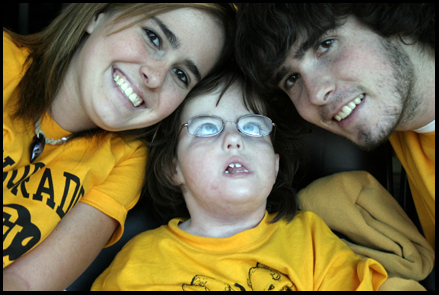


The Compassionate Friends
The mission of The Compassionate Friends is to assist families toward the positive resolution of grief following the death of a child of any age and to provide information to help others be supportive. This site also offers support to surviving siblings. Newsletters and brochures are available at minimal cost.
Related Books
September 2006 - IDEA Resources
It is time for school and that can mean changes for families. Your child could be starting or continuing home-based services or you could be taking your child to a center or play group. Or you may be putting your older child on a school bus for the first time. Or your child may meet new teachers and therapists and more!
The resources below include links to information about your rights, state level contacts and ways you can be involved in designing your child’s educational program.
The Individuals with Disabilities Education Act (IDEA) has recently been reauthorized. Most services and supports are still part of the law but there are also changes. You can access Fact Sheets about the changes in both HTML and PDF formats.
In addition, there are proposed regulations for IDEA services and supports for infants and toddlers (referred to as “Early Intervention” or Part C) or for children over the age of three (referred to as “school age services” or Part B).
The National Early Childhood Technical Assistance Center (NECTAC) is a program of the FPG Child Development Institute of the University of North Carolina at Chapel Hill. NECTAC supports the implementation of the early childhood provisions of the Individuals with Disabilities Education Act (IDEA). Our mission is to strengthen service systems to ensure that children with disabilities (birth through five) and their families receive and benefit from high quality, culturally appropriate, and family-centered supports and services. [reference]
One of the resources available from NECTAC is a listing of State Part C Coordinators as well as State Part B Coordinators. Contact information is provided and you are encouraged to call or email with questions or concerns.
The most important thing you can do is be knowledgeable of your rights and responsibilities as a parent of child with a disability. NECTAC provides a variety of resources on this topic including the family’s role on the early intervention team, participation in developing your infant or toddler’s Individualized Family Support Plan as well as the procedures in preparing an Individualized Education Plan for preschoolers and school age children.
- Assuring the family’s role on the early intervention team: Explaining rights and safeguards.
- Graphic of The Early Intervention / IFSP Process
- Involving parents in the IEP process

There are also a number of family support organizations with information, resources and other supports. Often, the individuals working in these organizations have a child with a disability and have first hand knowledge of IDEA and its many parts.
Throughout the United States, there are six regional parent centers. The Technical Assistance Alliance for Parent Centers is an innovative project that supports a unified technical assistance system for the purpose of developing, assisting and coordinating Parent Training and Information Projects and Community Parent Resource Centers under the Individuals with Disabilities Education Act (IDEA). This project is funded by the U.S. Department of Education, Office of Special Education Programs and consists of 1 national center and 6 regional centers. The project is funded to strengthen the connections to the larger technical assistance network and fortify partnerships between parent centers and state education systems at regional and national levels.
Parent Training and Information Centers (PTIs) and Community Parent Resource Centers (CPRCs) in each state provide training and information to parents of infants, toddlers, children, and youth with disabilities and to professionals who work with children. This assistance helps parents to participate more effectively with professionals in meeting the educational needs of children and youth with disabilities. The Parent Centers work to improve educational outcomes for children and youth with all disabilities (emotional, learning, mental, and physical). [reference]
The mission of PACER Center is to expand opportunities and enhance the quality of life of children and young adults with disabilities and their families, based on the concept of parents helping parents. Through its ALLIANCE and other national projects, PACER, a national center, responds to thousands of parents and professionals each year. From California to Minnesota to New York, PACER resources make a difference in the lives of 6.5 million children with disabilities nationwide. With assistance to individual families, workshops, materials for parents and professionals, and leadership in securing a free and appropriate public education for all children, PACER's work affects and encourages families in Minnesota and across the nation.
October 2006 - Assistive Technology Devices
Assistive Technology Devices
With so many assistive technology devices available, it is difficult to know which one is right for your child. Between toggle switches, mouth sticks, light pointers, jelly bean switches, trackballs, touch screens, BIG mack switches, sip-and-puff systems, and wands, there is a great deal of information to go through. TRIS has compiled information on BIG mack, jellybean, and toggle switches to help make the search easier for you and your family.
The resources below provide information and links about BIG mack switches, jelly bean switches, and toggle switches. The links provide general information, prices, and availability. Many of the links we have listed also provide information on new products, along with information about loaning libraries.
BIG mack switches are used by many people because it is simple to operate and has digital technology which allows audio recording for up to 20 seconds. The BIG mack also offers a one shot timer to prevent sound repetition. Both of these attributes could be helpful tools in your child’s learning.
You should also browse the products at Ablenet.
Jellybean switches are easy to use and adapt to your child’s needs. Jellybean switches are available in many models, colors, and sizes. Jellybean switches are the updated version of the BIG mack or big red switch. It is more compact which means it will not take up as much space in front of your child as the BIG mack or big red switch did. Jellybean switches are activated wherever your child presses on the top surface, and are durable enough for years of use. Prices of jellybean switches can vary, we have included several links with varying prices.
- Jellybean switches at Technical Solutions
- Jellybean switches at Notiva Children Services
New in 2005, the Jelly Beamer, a wireless jellybean switch. The Jelly Beamer’s wireless capabilities it can easily be passed between students, does not clutter the work area with wires and fosters turn-taking.
- Jelly Beamers at the IntelliTools Online Store
- Jelly Beamers at EnableMart
A toggle switch a type of electrical switch that use a mechanical lever, handle, or rocking mechanism for activation. Toggle switches are available in many different styles and sizes. Information on ordering and installing are located at :
- Action Electronics
- Standard Carling Technology
- Honeywell
There are many mounting systems that can be used with many switches. For example, the Magic Arm, Slim Armstrong, and the Universal Switch Mounting System can be used. The Magic Arm has a base clamp that will securely attach to anything. It stays in place and can be attached to any keyboard. Slim Armstrong can be adjusted in place any length you need. It stretches from 4” to 20.5” and rotates 360 degrees so it can be used in any situation. The Universal Switch Mounting System can be used anywhere with any switch. The versatility of this mounting system makes it a helpful accessory for any child.
Find ordering and pricing information for all of these mounting systems at EnableMart.
While looking for information about switches, TRIS came across loan libraries where parents may try out assistive technology for a trial period to determine if the device meets their child’s needs. This trial use will also allow the user to gain experience before purchasing the device. We are including several links for loan libraries in the United States.
IPAT Technology Access Center
Oregon Technology Access Program
Easter Seals Disability Services
Mississippi Bend Area Education Agency
Western Kentucky Assistive Technology Center
November 2006 - Walkers, Standers and Gait Trainers
Walkers, Standers and Gait Trainers
From different brands to different styles, there are many adaptive equipment options on the market. In order to make finding the right equipment for your child easier, TRIS has complied information about several adaptive equipment products for you.
This month TRIS is providing information on walkers, standers, and gait trainers for you and your family.
Walkers
 Walkers generally provide support for individuals needing limited assistance with standing or balancing on their own. Walkers assist children with increased upper trunk support, weight bearing abilities, and leg positioning. Some walkers are designed with the frame in the front and some have the frame in the rear. In order to decide which best fits your child; a physical therapist should be involved during the final decision process. Many manufactures provide websites with information about their products and helpful tips to make the choice easier for you. Manufacturers of walkers include Kaye, Dynamico, Birillo, and Grillo.
Walkers generally provide support for individuals needing limited assistance with standing or balancing on their own. Walkers assist children with increased upper trunk support, weight bearing abilities, and leg positioning. Some walkers are designed with the frame in the front and some have the frame in the rear. In order to decide which best fits your child; a physical therapist should be involved during the final decision process. Many manufactures provide websites with information about their products and helpful tips to make the choice easier for you. Manufacturers of walkers include Kaye, Dynamico, Birillo, and Grillo.
Information found at each of these links include sizing options, indoor and outdoor modifications, additional accessories, and an OT and PT on staff to work directly with you and your therapist.
Standers
 Standers offer the opportunity for graduated weight bearing, promote normal tone distribution and stability, and to facilitate selective extension of the spine. Standers also stimulate head-righting, weight-bearing on the forearms and mid-line hand use.
Standers offer the opportunity for graduated weight bearing, promote normal tone distribution and stability, and to facilitate selective extension of the spine. Standers also stimulate head-righting, weight-bearing on the forearms and mid-line hand use.
Another important aspect of standers is their ability to allow a child the opportunity for peer interaction. Most standers change in height so the product can be used over a period of years.
Information about standers can be found through manufacturers such as Snug Seat, Dondolino, Leckey, and Mulholland.
Gait Trainers
 Gait trainers have been designed to provide support and stability for children who need more assistance than a conventional walker. Gait trainers have numerous benefits. Socially, gate trainers can give a child the opportunity to interact with their peers and move freely around their classroom, home, etc. to explore on their own. The versatility of gait trainers allow students to participate in numerous developmentally appropriate activities. Gait trainers come in a variety of sizes and models. Information about gait trainers can be found at the following manufacturer sites: Mulholland, Cricket, Snug Seat, Dynamico, Grillo, Birillo, and Leckey.
Gait trainers have been designed to provide support and stability for children who need more assistance than a conventional walker. Gait trainers have numerous benefits. Socially, gate trainers can give a child the opportunity to interact with their peers and move freely around their classroom, home, etc. to explore on their own. The versatility of gait trainers allow students to participate in numerous developmentally appropriate activities. Gait trainers come in a variety of sizes and models. Information about gait trainers can be found at the following manufacturer sites: Mulholland, Cricket, Snug Seat, Dynamico, Grillo, Birillo, and Leckey.
Making the Decision
When deciding which stander, walker, or gait trainer is right for your child, you will need to consult your child's Occupational and/or Physical therapist. They will assist you and make sure you choose the best equipment to support your children at their highest functioning level.
Manufacturers such as Adaptive Mall have Occupational and Physical Therapists staffed, ready to aid you in the decision and purchasing process.
Loan Libraries for Adaptive Equipment
TRIS also came across information about adaptive equipment loan libraries. Loan libraries offer an opportunity for your child to test out the equipment to see if it meets all of his/her needs. Many of the loan libraries require completion of an equipment loan form or a membership form, and pay a membership fee, some costing up to $100.00 per year. Information was also found on loan libraries accepting financial aid.
An example of loan libraries and the services they offer are IPAT Equipment Loan Libraries.
December 2006 - Holiday Gifts
Holiday Gifts
With the holiday season quickly approaching, TRIS is offering information on adaptive toys and games in order to help you this gift-giving season.
Play is an important part of every child's development. Through play a child learns to control and interact with his or her physical environment, interact with others, and develop self-esteem.
There are manufactures that have developed lists of suggested toys such as Toys R Us that provide all children learning opportunities during play. Another great place to look is on EBay. An great idea would be to do your homework on some of the sites provided, find the toys you want to purchase, and then see if you can find a ‘gently used’ one on EBay for a lot less than retail prices.
TRIS has divided information about adaptive toys into three price ranges to assist you in your choices.
Toys and games under $25
Toys and games under $25 that focus on auditory, fine motor, gross motor, visual, and tactile are easy to find online or in catalogs. Examples of tactile toys for children are the Bounce and Giggle Animals by Beyond Play priced at $14.95 and Spinning Balls Top also by Beyond Play priced at $14.95. If you are looking for a toy that encourages auditory, fine motor, tactile, gross motor, visual and language skills try the Discovery Ball by LeapFrog priced at $19.99.
Toys and games up to $50
If your budget allows for up to $50, consider the Musical Hands Mat by Beyond Play priced at $29.95. This toy allows children to listen to different melodies as buttons are pressed and is a great toy for developing sensory and auditory skills. Another option is the Double-Sided Activity Center that can be attached to a wheelchair or crib, or positioned on the floor. This toy promotes fine motor skills and cognitive development. It is priced at $39.95 at Beyond Play.
Toys and Games over $50
There are also many adaptive toys over $50. If your child likes to music, then the Nuerosmith Together Tunes Block is a great toy. Priced at $63.00, this toy is an oversized fabric block that begins to sings as soon as your child turns it on its side. To find more information about ordering the Tunes Block, visit Small World Toys.
The Flying Colors Basic Finger Fascination is great for all children and allows a for sensory stimulation. It is priced at $92.95 and can be ordered from FLAGHOUSE.
The Busy Box is a toy that provides stimulation and finger isolation. With the touch of a button, the Busy Box lights up, vibrates, gives off a gentle breeze, or sings. Priced at $157.95, you can find ordering information at Enabling Devices.
Also look at the Soft Frame Bubble Mirror which creates multiple images plus changes of shape and sizes and available at Beyond Play, it is priced at $189.00.
February 2007 - Feeding and Dining
Feeding and Dining
To make mealtimes easier for you and your child, TRIS has complied feeding and dining information for this month’s Family Resources. Manufacturers such as Sammons Prestonand Beyond Play offer great utensil alternatives, food catchers, cups, and scoop bowls.
 Angled utensils promote greater success with hand-to-mouth feeding and are ideally shaped for small hands. EasieEaters Curved Utensils are available from Beyond Play and are offered with or without safety shields. The shields are intended to prevent the spoon or fork from going too far back into the child’s mouth. Spoon and fork sets are available for right or left hands for $7.50. Pediatric Flexible Utensils have foam handles which can be customized to fit a child’s grasp and skill level. Forks and spoons are available from Sammons Preston for $10.49 each. Another option is a utensil holder which assists children to grip the utensil and promote independent feeding. Different models are available from Sammons Preston ranging from $12-$29.00.
Angled utensils promote greater success with hand-to-mouth feeding and are ideally shaped for small hands. EasieEaters Curved Utensils are available from Beyond Play and are offered with or without safety shields. The shields are intended to prevent the spoon or fork from going too far back into the child’s mouth. Spoon and fork sets are available for right or left hands for $7.50. Pediatric Flexible Utensils have foam handles which can be customized to fit a child’s grasp and skill level. Forks and spoons are available from Sammons Preston for $10.49 each. Another option is a utensil holder which assists children to grip the utensil and promote independent feeding. Different models are available from Sammons Preston ranging from $12-$29.00.
Food Catchers are also helpful at meal time. Alternative bibs can help save your child’s clothing and furniture from stains.
Some are made from terry cloth and come in different sizes ranging from standard to jumbo. A package of three is available from Sammons Preston for $21.95. Waterproof bibs are also available in different colors and designs. Beyond Play offers a waterproof bib with sleeves for $19.95 which is machine washable. If you are looking for something that you can dispose of after every meal, you can buy a pack of 50 plastic food catchers on EBay for $15.00.
If you have the materials and time to make your own bibs, consider using old towels and bandanas. Clothes and fabric scraps are also great alternatives to store-bought bibs and food catchers.
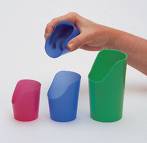 There are many modifications to drinking cups on the market. The Flexi Cut Cup comes in three sizes and promotes drinking without neck extension. Prices range from $7.95-10.50 and ordering information can be found at Beyond Play. If a cup with a lid is what you are looking for, try the Feeding Cup or the Wonder-Flo Cup both from Sammons Preston each under $10.00. Many children use straws and it is important to find the one to fit your child’s needs. Sammons Preston offers Reusable Drinking Straws which are 18`` long and come in flexible polyethylene or rigid Plexiglas. Both styles are latex free. Prices range from $7.95 to 17.95.
There are many modifications to drinking cups on the market. The Flexi Cut Cup comes in three sizes and promotes drinking without neck extension. Prices range from $7.95-10.50 and ordering information can be found at Beyond Play. If a cup with a lid is what you are looking for, try the Feeding Cup or the Wonder-Flo Cup both from Sammons Preston each under $10.00. Many children use straws and it is important to find the one to fit your child’s needs. Sammons Preston offers Reusable Drinking Straws which are 18`` long and come in flexible polyethylene or rigid Plexiglas. Both styles are latex free. Prices range from $7.95 to 17.95.
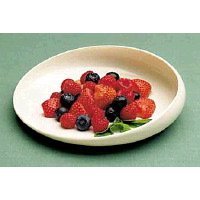
 Scoop bowls and plates are also useful for feeding because the “inner wall” and built in guard facilitates one-handed eating when pushing food onto spoons or forks. A basic scooper bowl can be purchased for under $10.00 from Colonial Medical Assisted Devices. If you are looking for a larger dish, try the Melamine Scoop Dish available on Amazon.
Scoop bowls and plates are also useful for feeding because the “inner wall” and built in guard facilitates one-handed eating when pushing food onto spoons or forks. A basic scooper bowl can be purchased for under $10.00 from Colonial Medical Assisted Devices. If you are looking for a larger dish, try the Melamine Scoop Dish available on Amazon.
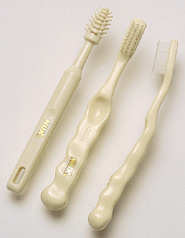 Oral Stimulation. Although your child may be tube fed, it is important to include your child during mealtime. The smells and sounds of this time are very important, and if possible tasting foods or oral stimulation exercises are important to encourage. Wide Smiles includes a list of oral motor exercises for your children's oral muscles for speech and other developmental skills. You may also purchase oral stimulation tools from Equipment Shop. Items such as the NUK Massager or Chewy Tubes are also helpful for oral stimulation.
Oral Stimulation. Although your child may be tube fed, it is important to include your child during mealtime. The smells and sounds of this time are very important, and if possible tasting foods or oral stimulation exercises are important to encourage. Wide Smiles includes a list of oral motor exercises for your children's oral muscles for speech and other developmental skills. You may also purchase oral stimulation tools from Equipment Shop. Items such as the NUK Massager or Chewy Tubes are also helpful for oral stimulation.
March 2007 - Feeding and Dining, Part 2
Feeding and Dining, Part 2
Last month TRIS focused on feeding and dining, and this month we are doing an extension of that topic. TRIS has developed a list of books that relate to feeding and dining that will assist you and your family at meal times.
A number of authors discuss guidelines for safe feeding practices for children with disabilities and stress the importance of distinguishing between feeding for the maintenance of health and feeding for the acquisition of skills.
EBay, Beyond Play, and Half.com are websites where you can find different books about meal time at home and in an educational setting.
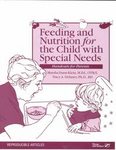 A great book that is directed towards helping parents through mealtime is Feeding and Nutrition for the Child with Special Needs: Handouts for Parents by Marsha Dunn Klein and Tracy A. Delaney. This book is available through Beyond Play.
A great book that is directed towards helping parents through mealtime is Feeding and Nutrition for the Child with Special Needs: Handouts for Parents by Marsha Dunn Klein and Tracy A. Delaney. This book is available through Beyond Play.
This is a comprehensive manual that will help parents design home treatment programs to address feeding and nutrition concerns. Handouts are also included in the text and offer information on nutrition guidelines, cup and straw drinking, oral-motor treatment strategies, and tube feedings.
 Another book that is written for parents of children with eating challenges is Just Take a Bite: Easy, Effective Answers to Food Aversions and Eating Challenges by Lori Ernsperger and Tania Stegen-Hanson. This is a practical guide to help families understand and work through underlying issues that can affect children during mealtime. It is available new and used at half.com.
Another book that is written for parents of children with eating challenges is Just Take a Bite: Easy, Effective Answers to Food Aversions and Eating Challenges by Lori Ernsperger and Tania Stegen-Hanson. This is a practical guide to help families understand and work through underlying issues that can affect children during mealtime. It is available new and used at half.com.
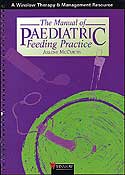 The last book that TRIS recommends is The Manual of Paediatric Feeding Practice by Arlene McCurtin. This book provides photo-copiable checklists and assessments for parents, teachers, and other specialists working with your child. It also addresses chewing, cup drinking, pre-feeding, positioning, nutritional intake, spoon feeding, swallowing, and tube to oral feeding.
The last book that TRIS recommends is The Manual of Paediatric Feeding Practice by Arlene McCurtin. This book provides photo-copiable checklists and assessments for parents, teachers, and other specialists working with your child. It also addresses chewing, cup drinking, pre-feeding, positioning, nutritional intake, spoon feeding, swallowing, and tube to oral feeding.
This book is available from Beyond Play through the catalog or online.
Remember to look for books on EBay and Half.com before ordering them from catalogs or online, often times they are available in new and used versions for lower prices!
April 2007 - Computer Games and Software
Computer Games and Software
With the world increasingly turning to computers, TRIS is focusing on computer games and software that can be or has been adapted for children with disabilities. Many of the available software and games are primarily educational and also beneficial for students with disabilities to interact with a computer to increase language and fine motor development.
Bright Start has software focusing on Applied Behavioral Analysis (ABA) including: attending, imitation, language, identification, categorizing and self help skills.
 Broken/No PictureA software option from eSpecial Needs Broken Link (formerly Bright Start) is ‘My House: Language Activities for Daily Living’. This program offers detailed, exploratory environments in which children learn about objects and activities encountered in daily living routines. This software builds functional language skills and increases independence.
Broken/No PictureA software option from eSpecial Needs Broken Link (formerly Bright Start) is ‘My House: Language Activities for Daily Living’. This program offers detailed, exploratory environments in which children learn about objects and activities encountered in daily living routines. This software builds functional language skills and increases independence.
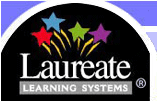 A special needs software company called Laureate features programs that train cause and effect, turn-taking, early vocabulary, syntax, cognitive concepts, auditory processing, and reading. Information of software program packages can be found at the website or by subscribing to the newsletter.
A special needs software company called Laureate features programs that train cause and effect, turn-taking, early vocabulary, syntax, cognitive concepts, auditory processing, and reading. Information of software program packages can be found at the website or by subscribing to the newsletter.
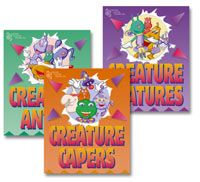 A series of software called ‘Creature Games’ are aimed towards helping children with multiple disabilities. Creature Antics, Creature Capers, Creature Features, Creature Cartoons, Creature Magic, and Creature Chorus can all be used to train cause and effect and turn-taking using switches. Advantages of this software series are its functionality and use with children as young as four months. Your child may interact with it using a keyboard, touching the screen, using a single switch or a mouse. Find more information about pricing and availability at ESpecial Needs(formerly Bright Start).
A series of software called ‘Creature Games’ are aimed towards helping children with multiple disabilities. Creature Antics, Creature Capers, Creature Features, Creature Cartoons, Creature Magic, and Creature Chorus can all be used to train cause and effect and turn-taking using switches. Advantages of this software series are its functionality and use with children as young as four months. Your child may interact with it using a keyboard, touching the screen, using a single switch or a mouse. Find more information about pricing and availability at ESpecial Needs(formerly Bright Start).
Smart-eStore is an online warehouse of software for children of all ages. Before looking into purchasing software from a catalog or specific company, search Smart-eStore to see if you can purchase it for a lower price.
EBay also is a great resource for software. It offers great on a wide variety of software titles. For more information, visit EBay and search ‘special needs software’.
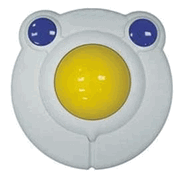 A bigger mouse will also allow your child to interact with the computer. The BIGtrack Kids Trackball makes computing easier for younger children. Available from Kid-Computers, the bright large 3" trackball helps to make mouse movements easy and accurate and the oversized buttons make mouse clicks easier for children with limited motor control. For increased access, the BIGtrack is available in a switch adapted version.
A bigger mouse will also allow your child to interact with the computer. The BIGtrack Kids Trackball makes computing easier for younger children. Available from Kid-Computers, the bright large 3" trackball helps to make mouse movements easy and accurate and the oversized buttons make mouse clicks easier for children with limited motor control. For increased access, the BIGtrack is available in a switch adapted version.
For other computer access devices, the TRIS Family Resource page has showcased switches before and you may access that information by clicking on ‘previous months’ Family Resource pages’ and selecting ‘October 2006’ or by following this link.
May 2007 - Summer Family Vacations
Summer Family Vacations
Summer is coming and that means family vacations, spending time outside, and traveling! In order to make these occasions easier for you and your family, TRIS has researched plane and train modifications for children with special needs and their families.
Most major airlines have a webpage devoted to accommodations for individuals with special needs.
Northwest Airlines works closely with authorities at all airports they serve to ensure increased accessibility for people with disabilities.
United Airlines also caters to people with disabilities by developing seats with movable armrest and having onboard wheelchairs available. United Airlines has also developed systems for making sure you can use your child's wheelchair when traveling.
American Airlines is making air travel easier for people with disabilities by consulting with disability groups for advice on costumer service and accessibility issues. American Airlines also maintains a team of specialists whose mission is to make flying as safe, convenient, and dignified as possible for customers with disabilities. For more information, visit the American Airlines website.
If you do not prefer air travel, traveling on a train is a great alternative. Amtrak has a page devoted to services for people with special needs. You can find information about accessible space on the train, stations accessibility, wheelchair restrictions, oxygen equipment, and meal service for customers with disabilities.
Summer 2007 - Museums
Museums
With summer here, TRIS knows that the time has come for traveling and vacation time with your family. While you are traveling to your summer destinations, a great idea would be to plan your stops around museum locations. Smaller museums in rural areas are a great place to spend an hour stretching your legs and allowing your children to learn and have fun in a stimulating and education environment.
 If you are traveling around the United States and would like to plan museum stops, visit Museums USA. Here you will be prompted to type in a city that you will be traveling to, and it will show you all of the museums and science centers in the area. This website will also give you information about hours of operation, price of admission, and street address.
If you are traveling around the United States and would like to plan museum stops, visit Museums USA. Here you will be prompted to type in a city that you will be traveling to, and it will show you all of the museums and science centers in the area. This website will also give you information about hours of operation, price of admission, and street address.
You might want to take into consider a family membership through a children’s museum or science center. With some museums and science centers, a membership entitles you and your family to free admission to other science centers and museums throughout the country. View the number of museums and science centers in each state by going to Museums USA. At this link, you will be given links for each state and by clicking on a specific state, you will be directed to a page with cities. Simply click on the city you will be passing through and receive information about the museum.
For example, at the Museums USA homepage, we typed in Champaign, IL and were able to view all ten museums that are located in the city. The Orpheum Children’s Science Museum provides children of all ages the chance to explore and learn science at their own pace in an informal setting. Our exhibits are designed to be fun, but also to teach about science.
Be sure to call ahead and check hours of operation. Programs and hours may vary during summer months.
September 2007 - Communicating With Your Child
Communicating With Your Child
Positive interactions with children are a very important part of their communication development. It helps increase their speech and language development in addition it also forms strong bonds between parents and children. Sometimes finding ways to communicate with young children or children with limited communication abilities can be difficult. Below you will find some suggestions for increasing communication with your children. In addition you will find included a few web resources with further ideas for increasing communication. You can expose your child to a large number and variety of words by making talking a part of everything you and your child do together. To a young child, the whole world is new and even the most routine activities are learning experiences. Try the suggestion below, and you will soon learn to recognize the hundreds of opportunities that each day offers to introduce your child to language.
Questions, answers and comments: Trips to therapy, preschool, the supermarket, post office, etc. should always be accompanied by lots of questions, answers, and comments.
Doing, seeing, feeling, and touching: Talk to your child about what you're doing, seeing, feeling, and touching while you cook dinner, vacuum the carpet, set the table, or simply pour your child a drink. As you name and describe different objects, you can increase your child's knowledge of their different characteristics; for example, you can talk about colors and textures.
Use specific words: Making only slight changes in the way you speak to your child can make a large difference in his vocabulary development. Instead of saying, "I will cut the sandwich for you," try saying, "I will cut the sandwich in half for you." Instead of "We will be there soon," try saying, "We will be there in two hours. Hearing language is the most important part whether your child is turning his head to your voice, learning new vocabulary words or speaking in full sentences.
Here are additional ideas on finding language opportunities in your child’s daily routines and activities.
For age and developmentally specific activities to encourage speech and language, you can visit the American Speech-Language-Hearing Association.
Another important aspect to speech and language development is making sure your child has a variety of literacy opportunities. Reading and singing to your child are great ways to provide literacy opportunities and encourage development in their communication skills. A great place to begin building positive literacy skills is at your public library. Search for a public library near you.
October 2007 - Cognitive Skills
Cognitive Skills
This month the TRIS team focuses on activities that will help children develop their cognitive skills. Cognitive skills are used in all daily activities, play, etc. During constructive play the child is faced with the task of finding ways to put objects together, such as Legos. During exploratory and investigative play, a child encounters new information and experiences. The child tries to make sense of these experiences through touch, smell, sight and sound. You can find many opportunities for cognitive play in your child’s daily activities Some examples of activities to promote cognitive play are listed below:
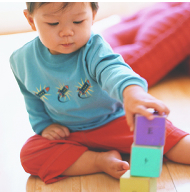 Puzzles - Jigsaw puzzles, wooden puzzles, 3 dimensional puzzles. Sensory play / Science Experiments- visit this link for some fun science experiments you can do at home.
Puzzles - Jigsaw puzzles, wooden puzzles, 3 dimensional puzzles. Sensory play / Science Experiments- visit this link for some fun science experiments you can do at home.
Books - Reading with you children each and everyday is a great way to improve not only cognitive development but many other aspects of your child’s development.
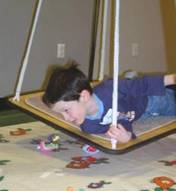 Sensory play is also a fun and interactive way to help your child develop and strengthen their cognitive abilities. The world is packed with sensory information. Bright lights, honking horns, shouting people, humid air, wet snow. Playing with their senses, or sensory play, is how children begin the process of sensory integration— processing, organizing and filtering sensory input and responding appropriately. Through sensory play children learn to concentrate and manage their emotional responses to sensory input. Sensory activities can be as simple as tickling or helping your child stretch to more involved sensory activities such as water play or helping in the kitchen. Follow this link for ideas on sensory activities that you can make and participate in with your child in the areas of tactile play, visual play, sound and play, smell and taste, and sensory integration.
Sensory play is also a fun and interactive way to help your child develop and strengthen their cognitive abilities. The world is packed with sensory information. Bright lights, honking horns, shouting people, humid air, wet snow. Playing with their senses, or sensory play, is how children begin the process of sensory integration— processing, organizing and filtering sensory input and responding appropriately. Through sensory play children learn to concentrate and manage their emotional responses to sensory input. Sensory activities can be as simple as tickling or helping your child stretch to more involved sensory activities such as water play or helping in the kitchen. Follow this link for ideas on sensory activities that you can make and participate in with your child in the areas of tactile play, visual play, sound and play, smell and taste, and sensory integration.
Cooking activities are also a fun ways to help develop cognitive skills and introduce sensory activities. Visit the following websites for great kid friendly recipes: Family Fun and Kids Cooking.
For tips on working with specific age groups in the kitchen visit Kitchen tips.
For picture recipes, try this link out for great ideas and resources: Picture recipes
For additional activities to help develop your child’s cognitive skills please visit: Cognitive play.
December 2007 - Social-Emotional Skills
Social-Emotional Skills
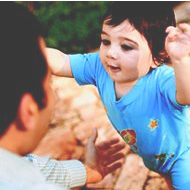 A child’s social-emotional skills assist her to communicate, connect with the world around her and resolve conflicts with others. As with other skills such as communication, cognitive, and physical development, a child needs practice to develop social-emotional skills. Social-emotional skills are not as easily seen as some of the other skills children learn such as rolling, reaching and vocalizing. Learning to identify our children’s cues and needs will help parents to promote their child’s social-emotional development.
A child’s social-emotional skills assist her to communicate, connect with the world around her and resolve conflicts with others. As with other skills such as communication, cognitive, and physical development, a child needs practice to develop social-emotional skills. Social-emotional skills are not as easily seen as some of the other skills children learn such as rolling, reaching and vocalizing. Learning to identify our children’s cues and needs will help parents to promote their child’s social-emotional development.
Below are some ideas for promoting social-emotional development in children:
- All children need to be comforted when they are upset. Hold your child. Speak soothingly and calmly. She will let you know when she is feeling okay again.
- Spend time with your child and help her explore her world and get to know the people in it.
- Young children need consistent routines. Have a few routines
and stick to them. - Let your child see your emotions. Point out when you are happy, sad or silly.
Social-emotional development follows certain stages. Here are some key milestones:
- Develop a sense of self and of belonging to a family.
- Develop a language-based communication system with parents and caregivers.
- Learn to separate from their parents.
- Learn words to label their emotions.
- Engage in pretend (make-believe) play.
- Play near other children but not with them — often imitating the actions of others.
- Play with other children.
- State their desires and wants.
- Share and take turns.
- Use words to solve conflicts and develop control of their emotions.
- Learn that it is okay to make a mistake.
- Develop self-confidence and self-respect.
- Develop respect for others and feelings of empathy.
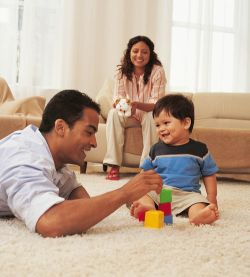 Both of the above lists can be accessed at the following websites.
Both of the above lists can be accessed at the following websites.
Ideas for Social-Emotional development and Social-Emotional Stages
For additional stages of social-emotional development please visit the following link.Social-Emotional Stages
For additional activities and ideas to promote your child’s social-emotional development, please try the this link. Social-Emotional Activities
Beyond Play offers many toys and games to help aid in your child’s social-emotional development. Follow the link to locate their website for additional ideas.


